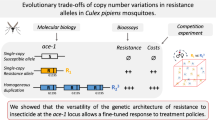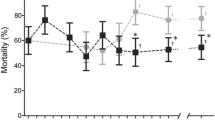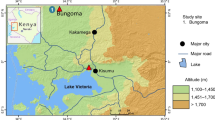Abstract
Resistance to organophosphate (OP) insecticide in the mosquito Culex pipiens has been studied for ca. 30 years. This example of micro-evolution has been thoroughly investigated as an opportunity to assess precisely both the new adapted phenotypes and the associated genetic changes. A notable feature is that OP resistance is achieved with few genes, and these genes have generally large effects. The molecular events generating such resistance genes are complex (e.g., gene amplification, gene regulation) potentially explaining their low frequency of de novo occurrence. In contrast, migration is a frequent event, including passive transportation between distant populations. This generates a complex interaction between mutations and migration, and promotes competition among resistance alleles. When the precise physiological action of each gene product is rather well known, it is possible to understand the dominance level or the type of epistasis observed. It is however difficult to predict a priori how resistance genes will interact, and it is too early to state whether or not this will be ever possible. These resistance genes are costly, and the cost is variable among them. It is usually believed that the initial fitness cost would gradually decrease due to subsequent mutations with a modifier effect. In the present example, a particular modifier occurred (a gene duplication) at one resistance locus, whereas at the other one reduction of cost is driven by allele replacement and apparently not by selection of modifiers.
Similar content being viewed by others
References
Berticat, C., Boquien, G., Raymond, M. & C. Chevillon, 2001. Insecticide resistance genes induce a mating competition cost in Culex pipiens mosquitoes. Genet. Res. (in press).
Berticat, C., M.-P. Dubois, M. Marquine, C. Chevillon & M. Raymond, 2000. A molecular test to identify resistance alleles at the Ester super locus in the mosquito Culex pipiens. Pest Manag. Sc. 56: 727–731.
Bost, B., C. Dillman & D. de Vienne, 1999. Fluxes and metabolic pools as model traits for quantitative genetics: 1. the L-shaped distribution of gene effects. Genetics 153: 2001–2012.
Bourguet D., R. Capela & M. Raymond, 1996. An insensitive acetylcholinesterase in Culex pipiens L. mosquitoes from Portugal. J. Econ. Entomol. 89: 1060–1066.
Bourguet, D., T. Lenormand, T. Guillemaud, V. Marcel & M. Raymond, 1997a. Variation of dominance of newly arisen adaptive genes. Genetics 147: 1225–1234.
Bourguet, D. & M. Raymond, 1998. The molecular basis of dominance relationships: the case of some recent adaptive genes. J. Evol. Biol. 11: 103–122.
Bourguet, D., M. Raymond, S. Berrada & D. Fournier, 1997b. Interaction between acetylcholinesterase and choline acetyltransferase: an hypothesis to explain unusual toxicological responses. Pest. Sc. 51: 276–282.
Callaghan, A., T. Guillemaud, N. Makate & M. Raymond, 1998. Polymorphism and fluctuations in copy number of amplified esterase genes in Culex pipiens mosquitoes. Insect Mol. Biol. 7: 295–300.
Chevillon, C., G. Addis, M. Raymond & A. Marchi, 1995a. Population structure in Mediterranean islands and risk of genetic invasion in Culex pipiens. Biol. J. Linn. Soc. 55: 329–343.
Chevillon, C., D. Bourguet, F. Rousset, N. Pasteur & M. Raymond, 1997. Pleiotropy of adaptive changes in populations: comparisons among insecticide resistance genes in Culex pipiens. Genet. Res. 68: 195–203.
Chevillon, C., N. Pasteur, M. Marquine, D. Heyse & M. Raymond, 1995b. Population structure and dynamics of selected genes in the mosquito Culex pipiens. Evolution 49: 997–1007.
Chevillon, C., M. Raymond, T. Guillemaud, T. Lenormand & N. Pasteur, 1999. Population genetics of insecticide resistance in the mosquito Culex pipiens. Biol. J. Linn. Soc. 68: 147–157.
Clark, A.G. & L. Wang, 1997. Epistasis in measured genotypes: Drosophila P-element insertions. Genetics 147: 157–163.
Clarke, G.M., J.L. Yen & J.A. McKenzie, 2000. Wings and bristles: character specificity of the asymmetry phenotype in insecticideresistant strains of Lucilia cuprina. Proc. R. Soc. Lond. B 267: 1815–1818.
Coyne, J.A., N.H. Barton & M. Turelli, 1997. Perspective: a critique of sewall wright' shifting balance theory of evolution. Evolution 51: 643–671.
Curtis, C.F. & N. Pasteur, 1981. Organophosphate resistance in vector populations of the complex Culex pipiens L. (Diptera, Culicidae). Bull. Ent. Res. 71: 153–161.
Curtis, C.F. & G.B. White, 1984. Plasmodium falciparum transmission in England: entomological and epidemiological data relative to cases in 1983. J. Trop. Med. Hyg. 87: 101–114.
Davies, A.G., A.Y. Game, Z. Chen, T.J. Williams, S. Goodall, J.L. Yen, J.A. McKenzie & P. Batterham, 1996. Scalloped wings is the Lucilia cuprina Notch homologue and a candidate for the Modifier of fitness and asymmetry of diazinon resistance. Genetics 143: 1321–1337.
de Visser, J.A.G.M., R.F. Hoekstra & H. Van den Ende, 1997. Test of interaction between genetic markers that affect fitness in Aspergillus niger. Evolution 51: 1499–1505.
Elena, S.F. & R.E. Lenski, 1997. Test of synergistic interactions among deleterious mutations in bacteria. Nature 390: 395–398.
Eritja, R. & C. Chevillon, 1999. Interruption of chemical control and evolution of insecticide resistance genes in Culex pipiens. J. Med. Entomol. 36: 41–49.
Fournier, D. & A. Mutero, 1994. Modification of acetylcholinesterase as a mechanism of resistance to insecticides. Comp. Biochem. Physiol. 108C: 19–31.
Gazave, E., C. Chevillon, T. Lenormand, M. Marquine & M. Raymond, 2001. Dissecting the cost of insecticide resistance genes during the overwintering period of the mosquito Culex pipiens Heredity 87: 1–8.
Georghiou, G. & N. Pasteur, 1978. Electrophoretic esterase patterns in insecticide-resistant and susceptible mosquitoes. J. Econ. Entomol. 71: 201–205.
Guillemaud, T., T. Lenormand, D. Bourguet, C. Chevillon, N. Pasteur & M. Raymond, 1998. Evolution of resistance in Culex pipiens: allele replacement and changing environment. Evolution 52: 430–440.
Guillemaud, T., N. Makate, M. Raymond, B. Hirst & A. Callaghan, 1997. Esterase gene amplification in Culex pipiens. Insect Mol. Biol. 6: 319–327.
Guillemaud, T., S. Rooker, N. Pasteur & M. Raymond, 1996. Testing the unique amplification event and the worldwide migration hypothesis of insecticide resistance genes with sequence data. Heredity 77: 535–543.
Haldane, J.B.S., 1924. A mathematical theory of natural and artificial selection: Part I. Cambridge Phil. Soc. Trans. 23: 19–41.
Highton, R.B. & E.C.C. van Someren, 1970. The transportation of mosquitoes between international airports. Bull. Wld Hlth Org. 42: 334–335.
Hilbish, T.J., B.L. Bayne & A. Day, 1994. Genetics of physiological differentiation within the marine mussel genus Mytilus. Evolution 48: 267–286.
Hoffmann, F., D. Fournier & P. Spierer, 1992. Minigenes rescues acetylcholinesterase lethal mutations in Drosophila melanogaster. J. Mol. Biol. 223: 17–22.
Hughes, A.L., 1994. The evolution of functionally novel proteins after gene duplication. Proc. R. Soc. Lond. B 256: 119–124.
Kacser, H. & J.A. Burns, 1981. The molecular basis of dominance. Genetics 97: 639–666.
Keightley, P.D., 1996. A metabolic basis for dominance and recessivity. Genetics 143: 621–625.
Kelly, J.K., 2000. Epistasis, linkage, and balancing selection, pp. 146–157 in Epistasis and the Evolutionary Process, edited by J.B. Wolf, E.D. Brodie III & M.J. Wade. Oxford University Press, New York.
Lande, R., 1983. The response to selection on major and minor mutations affecting a metrical trait. Heredity 50: 47–65.
Lees, D.R., 1981. Industrial melanism: genetic adaptation of animals to air pollution, pp. 129–176 in Genetic Consequences of Man Made Change, edited by J.A. Bishop & L.M. Cook. Academic Press, London.
Lenormand, T., D. Bourguet, T. Guillemaud & M. Raymond, 1999. Tracking the evolution of insecticide resistance in the mosquito Culex pipiens. Nature 400: 861–864.
Lenormand, T., T. Guillemaud, D. Bourguet & M. Raymond, 1998a. Appearance and sweep of a gene duplication: adaptive response and potential for a new function in the mosquito Culex pipiens. Evolution 52: 1705–1712.
Lenormand, T., T. Guillemaud, D. Bourguet & M. Raymond, 1998b. Evaluating gene flow using selected markers: a case study. Genetics 149: 1383–1392.
Lenormand, T. & M. Raymond, 1998. Resistance management: the stable zone strategy. Proc. R. Soc. Lond. B 65: 1–6.
Lenormand, T. & M. Raymond, 2000. Clines with variable selection and variable migration: model and field studies. Am. Nat. 155: 70–82.
MacNair, M.R., 1991. Why the evolution of resistance to anthropogenic toxins normally involves major gene changes: the limits to natural selection. Genetica 84: 213–219.
McKenzie, J.A., 1996. Ecological and Evolutionary Aspects of Insecticide Resistance. Academic Press, Georgetown, Texas.
Nagylaki, T., 1975. Conditions for the existence of clines. Genetics 80: 595–615.
Orr, H.A., 1998. The population genetics of adaptation: the distribution of factors fixed during adaptive evolution. Evolution 52: 935–949.
Orr, H.A. & J.A. Coyne, 1992. The genetics of adaptation: a reassessment. Am. Nat. 140: 725–742.
Parsch, J., J.A. Russel, I. Beerman, D.L. Hartl & W. Stephan, 2000. Deletion of a conserved regulatory element in the Drosophila Adh gene leads to increased alcohol dehydrogenase activity but also delays development. Genetics 156: 219–227.
Pasteur, N., A. Iseki & G.P. Georghiou, 1981. Genetic and biochemical studies of the highly active esterases A' and B associated with organophosphate resistance in mosquitoes of the Culex pipiens complex. Biochem. Genet. 19: 909–919.
Pasteur, N., M. Marquine, H. Ben Cheikh, C. Bernard & D. Bourguet, 1999. A new mechanism conferring unprecedented high resistance to chlorpyrifos in Culex pipiens (Diptera: Culicidae). J. Med. Entomol. 36: 794–802.
Pasteur, N., M. Marquine, F. Rousset, A.-B. Failloux, C. Chevillon & M Raymond, 1995. The role of passive migration in the dispersal of resistance genes in Culex pipiens quinquefasciatus within french polynesia. Genet. Res. 66: 139–146.
Pasteur, N., M. Marquine, H.H. Tran, S.N. Vu & A.-B. Failloux, 2001. Overproduced esterase in Culex pipiens quinquefasciatus from Vietnam. J. Med. Entomol. 38: 740–745.
Pasteur, N., E. Nancé & N. Bons, 2001. Tissue localization of overproduced esterases in the mosquito Culex pipiens L. J. Med. Entomol. 38 (in press).
Pasteur, N. & G. Sinègre, 1978. Autogenesis versus esterase polymorphism and chlorpyrifos (Dursban) resistance in Culex pipiens pipiens L. Biochem. Genet. 16: 941–943.
Pasteur, N., G. Sinègre & A. Gabinaud, 1981. Est-2 and Est-3 polymorphism in Culex pipiens L. from southern France in relation to organophosphate resistance. Biochem. Genet. 19: 499–508.
Poirié, M., M. Raymond & M. Pasteur, 1992. Identification of two distinct amplifications of the esterase B locus in Culex pipiens (L.) mosquitoes from Mediterranean countries. Biochem. Genet. 30: 13–26.
Qiao, C.-L., M. Marquine, N. Pasteur & M. Raymond, 1998. A new esterase amplification involved in OP resistance in Culex pipiens mosquitoes from China. Biochem. Genet. 36: 417–426.
Qiao, C.-L. & M. Raymond, 1995. The same esterase B1 haplotype is amplified in insecticide resistant mosquitoes of the Culex pipiens complex from the Americas and China. Heredity 74: 339–345.
Raymond, M., A. Callaghan, P. Fort & N. Pasteur, 1991.Worldwide migration of amplified insecticide resistance genes in mosquitoes. Nature 350: 151–153.
Raymond, M., C. Chevillon, T. Guillemaud, T. Lenormand & N. Pasteur, 1998. An overview of the evolution of overproduced esterases in the mosquito Culex pipiens. Phil. Trans. R. Soc. Lond. B 353: 1–5.
Raymond, M., D. Heckel & J.G. Scott, 1989. Interaction between pesticide genes: model and experiment. Genetics 123: 543–551.
Raymond, M. & M. Marquine, 1994. Evolution of insecticide resistance in Culex pipiens populations: the Corsican paradox. J. Evol. Biol. 7: 315–337.
Raymond, M., N. Pasteur, G.P. Georghiou, R.B. Mellon, M.C. Wirth & M.K. Hawley, 1987. Detoxification esterases new to California, USA, in organophosphate-resistant Culex quinquefasciatus (Diptera: Culicidae). J. Med. Entomol. 24: 24–27.
Raymond, M., C.L. Qiao & A. Callaghan, 1996. Esterase polymorphism in insecticide susceptible populations of the mosquito Culex pipiens. Genet. Res. 67: 19–26.
Rivet, Y., M. Marquine & M. Raymond, 1993. French mosquito populations invaded by A2–B2 esterases causing insecticide resistance. Biol. J. Linn. Soc. 49: 249–255.
Rooker, S., T. Guillemaud, J. Bergé, N. Pasteur & M. Raymond, 1996. Coamplification of esterase A and B genes as a single unit in the mosquito Culex pipiens. Heredity 77: 555–561.
Severini, C., R. Romi, M. Marinucci, T. Guillemaud & M. Raymond, 1997. Esterases A5–B5 in organophosphate-resistant Culex pipiens from Italy. Med. Vet. Entomol. 11: 123–126.
Severini, C., R. Romi, M. Marinucci & M. Raymond, 1993. Mechanisms of insecticide resistance in field populations of Culex pipiens from Italy. J. Am. Mosq. Cont. Assoc. 9: 164–168.
Silvestrini, F., C Severini, V. Di Pardo, R. Romi, E. De Matthaeis & M. Raymond, 1998. Population structure and dynamics of insecticide resistance genes in Culex pipiens populations from Italy. Heredity 81: 342–348.
Slatkin, M., 1973. Gene flow and selection in a cline. Genetics 75: 733–756.
Slatkin, M., 1987. Gene flow and the geographic structure of natural populations. Science 236: 787–792.
Weill, M., C. Berticat, M. Raymond & C. Chevillon, 2000. Quantitative PCR to estimate the number of amplified esterase genes in insecticide resistant mosquitoes. Analytic. Biochem. 285: 267–270.
Weill, M., M. Marquine, A. Berthomieux, M.-P. Dubois, C. Bernard, C.L. Qiao & M. Raymond, 2001. The diversity of amplified esterase gene in Chinese Culex pipiens mosquitoes J. Am. Nosq. Cont. Assoc. 17: (in press).
Xu, J., F. Qu & W. Liu, 1994. Diversity of amplified esterase B genes responsible for organophosphate resistance in Culex quinquefasciatus from China. J. Med. Coll. PLA 9: 20–23.
Author information
Authors and Affiliations
Rights and permissions
About this article
Cite this article
Raymond, M., Berticat, C., Weill, M. et al. Insecticide resistance in the mosquito Culex pipiens: what have we learned about adaptation?. Genetica 112, 287–296 (2001). https://doi.org/10.1023/A:1013300108134
Issue Date:
DOI: https://doi.org/10.1023/A:1013300108134




